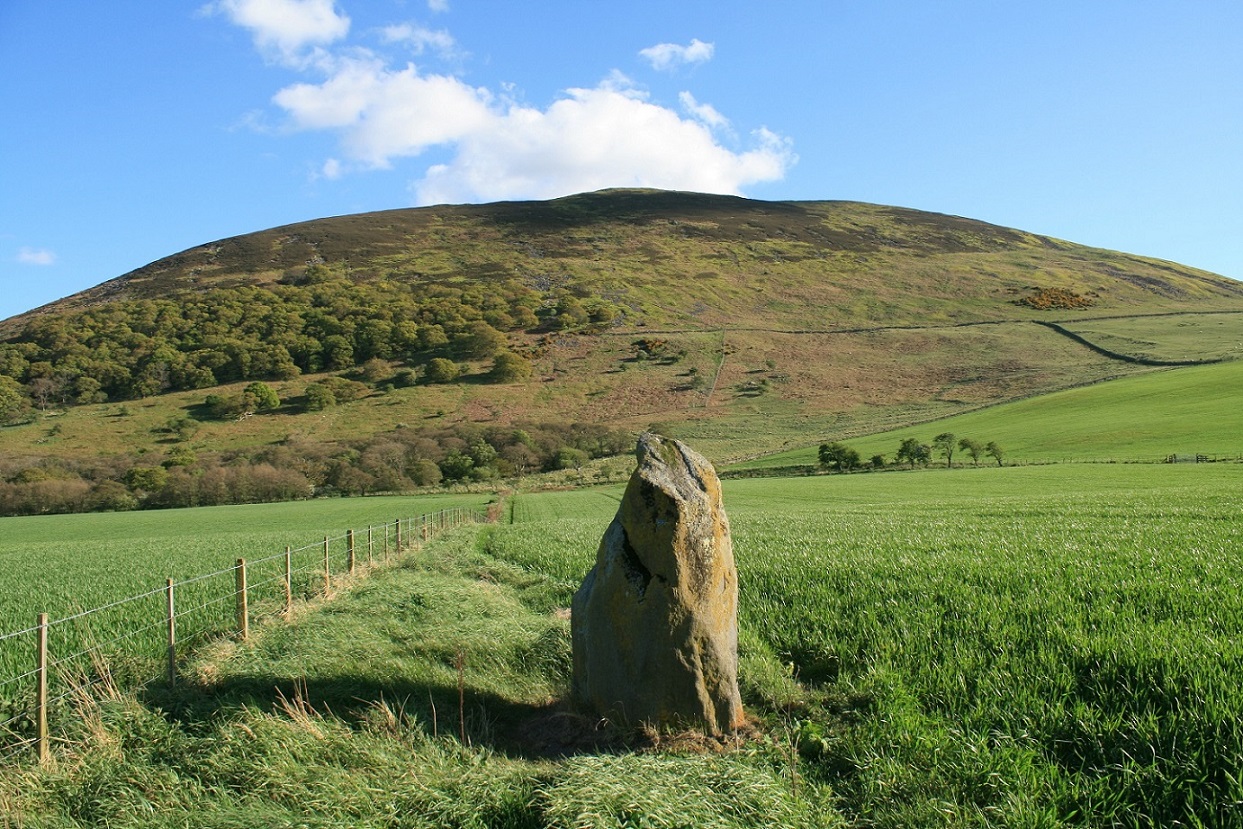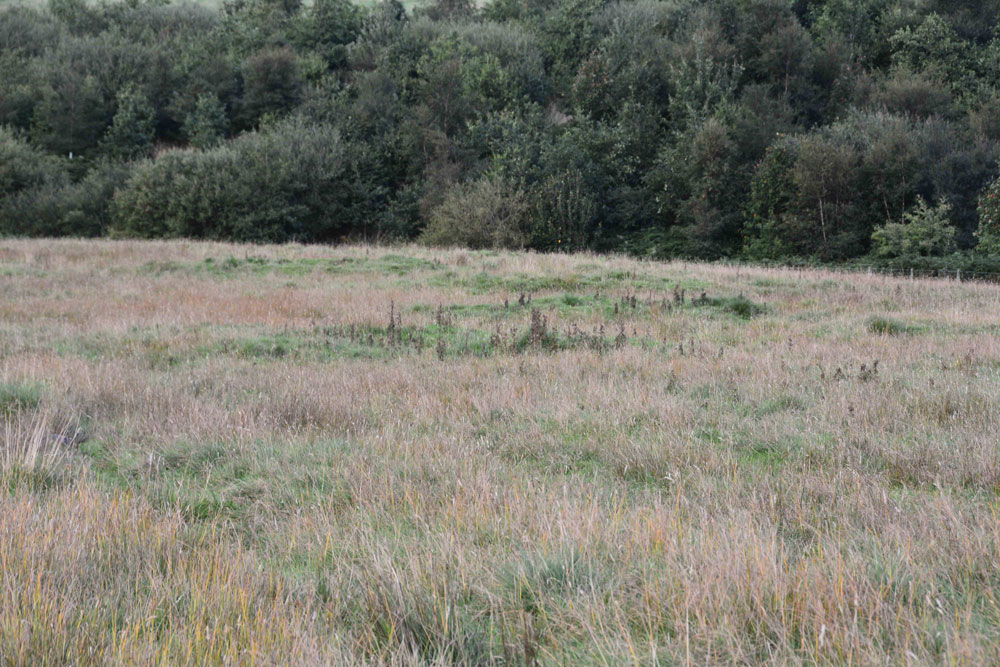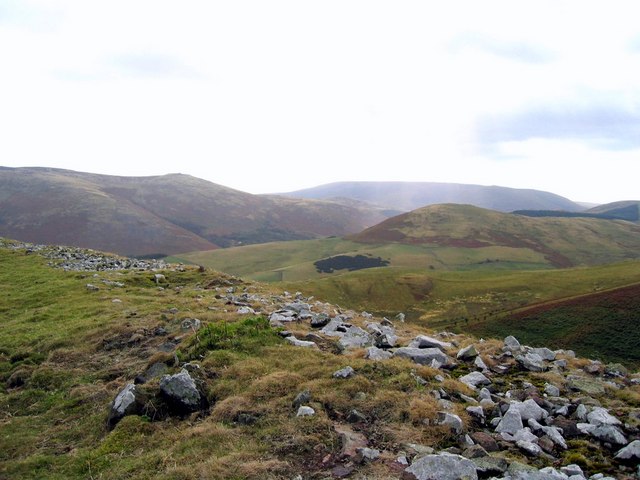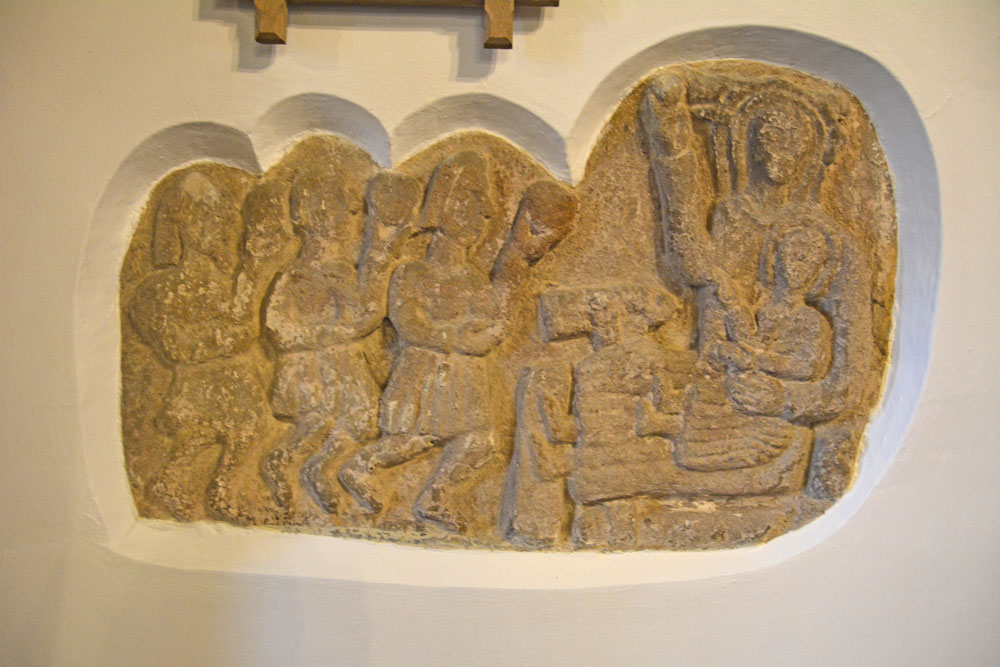Contributory members are able to log private notes and comments about each site
Sites Anne T has logged on trip number: 41 (View all trips)
View this log as a table or view the most recent logs from everyone
Battle Stone (Kirknewton)
Trip No.41 Entry No.2 Date Added: 27th Aug 2017
Site Type: Standing Stone (Menhir)
Country: England (Northumberland)
Visited: Yes on 26th Aug 2017. My rating: Condition 3 Ambience 4 Access 4

Battle Stone (Kirknewton) submitted by Postman on 14th Jun 2017. With Yeavering bell as backdrop, one day I'll get up there too.
(View photo, vote or add a comment)
Log Text: Battle Stone, Kirknewton: This was our second unscheduled stop of the day, and one I was very pleased to have made.
Having turned off the A697 onto the B6351, just before the site of Ad Gefrin to the west, I spotted this stone on the OS map. Goodness knows how I’d missed it before, but then it’s a tiny little dot right on the edge of two maps we were using (OL16 and 339).
The stone is in a large field just under the shadow of Yeavering Bell, which glowed purple with the heather. There is a largish entrance to the field, hard-cored over, but the field was covered in ripening wheat. We could see the stone from afar and managed to follow the tractor path to about 8 metres away.
The stone had very different shapes, depending on what angle we viewed it at. Looking at the Historic England notes when we got back home, discovered that there are the remains of Old Yeavering Henge, which is preserved as a cropmark and lies 150m to the WNW, so it would be interesting to go back next spring, when the crop has been harvested and the field might be under grass.
We continued along the B6351 towards Kilham and Ring Chesters.
Bendor Stone
Trip No.41 Entry No.1 Date Added: 27th Aug 2017
Site Type: Standing Stone (Menhir)
Country: England (Northumberland)
Visited: Yes on 26th Aug 2017. My rating: Condition 3 Ambience 4 Access 5

Bendor Stone submitted by kelpie on 16th May 2004. Standing stone found at NT96814 29428. Clearly visible from the road this stone is also known as The Battle stone as it is associated with the Battle of Homildon Hill in 1402, however, the stone itself was likely to have been erected in the Bronze Age.
(View photo, vote or add a comment)
Log Text: The Battle Stone, Bendor: The A697 was busy with holiday traffic today, and with a longish walk ahead of us, we stopped off in a very busy Wooler for refreshments, we headed off towards Kilham and Ring Chesters. As we whizzed along the A697 westwards, I spotted this stone standing in the middle of a field to the north of the road. Husband immediately turned right down the minor road leading to Bendor, a small hamlet just off the road. There was no parking here, just large private forecourts and it seemed the whole village was standing round talking, swinging round to look at us as we turned the car around.
Andrew had spotted a very narrow gateway which sloped down to the gate into the field at NT 96838 29400; this was litter-strewn and not suitable to take the car down. Pulling as far off the road as he could, I took the opportunity to clamber out and walk down to the gate. There was nothing in the field apart from a few curious sheep. Andrew said it was too dangerous to get out of the car, so I did something I wouldn’t normally do and let myself into the field and walked the 20 metres or so to the stone, telling myself if someone noticed me I’d ask permission.
Quickly taking photographs, particularly one with Yeavering Bell in the background (a bit difficult as the light was brightest in that direction and the camera was compensating), I headed back to the car and we turned around ready to resume our journey to Kilham.
Elsdonburn Shank (Kilham)
Trip No.41 Entry No.4 Date Added: 28th Aug 2017
Site Type: Ancient Village or Settlement
Country: England (Northumberland)
Visited: Yes on 26th Aug 2017. My rating: Condition 2 Ambience 4 Access 3

Elsdonburn Shank (Kilham) submitted by Anne T on 28th Aug 2017. Enclosure A from the northern-most part of the bank of Enclosure B.
(View photo, vote or add a comment)
Log Text: Elsdonburn Shank Villages, Kilham: Why are all the interesting sites up, up, up hill?? From Longknowe Settlement, we drove to Thompsons Walls and parked just behind their stack of sileage bales. The footpath continues here, and is metalled, but is a private road, so we decided not to drive any further.
It is a very pleasant walk along this road, with the hills looming around you on three sides. The ground looks very fertile here, and there were many, many sheep and their lambs on the green pasture. The farmer passed me with his large mower and gave a great wave. We later saw him mowing the grass in a meadow on the other side of the valley.
The footpath splits at the point where a burn tumbles down from a wood and goes underneath the road. We took the left hand fork which runs up to Elsdonburn Shank Farm, the house now deserted but the land and barn still used.
Just before the barn, the footpath dives off diagonally south east across the field, leading down to a gate just before the stream. It looks at first glance as if this stream is going to be wide, because the valley is quite deep, but when you get down to it, it’s just a little trickle, with a few stones placed across to make it easy to cross. From here, the footpath disappeared, and we ended up tracked north east up the hill, led by a string of large boulders which seemed (to us) to mark the track. In fact higher up, the footpath has been mown of bracken and leads along the fence line up the hill.
Just as I was getting tired of clambering up the slope, Village A came into view and we sat on the western side of the bank to have a drink before exploring. Well worth coming up here. Enclosure A was easier to decipher than B, which had much more bracken growing within it, and a tumble of stones peeking out of the grass.
With the dark skies getting darker, we plodded up the hill towards Ring Chesters.
Elsdonburn Shank Shielings (Kilham)
Trip No.41 Entry No.6 Date Added: 28th Aug 2017
Site Type: Ancient Village or Settlement
Country: England (Northumberland)
Visited: Yes on 26th Aug 2017. My rating: Condition 1 Ambience 3 Access 3

Elsdonburn Shank Shielings (Kilham) submitted by Anne T on 28th Aug 2017. Having walked by these shielings on the way up the hill, they were actually far more visible coming down the track from Elsdonburn Shank farm. The turf covered foundations, like Longknowe Settlement nearby, stood out as a darker green with lower growing grass, as opposed to the yellowing stems of taller grass around them.
(View photo, vote or add a comment)
Log Text: Elsdonburn Shank Shielings, Kilham: Husband had read somewhere that these might possibly have Saxon origins, although I’ve not been able to find the link.
Marked on the OS map as ‘old shielings’ we missed these on the walk up to Elsdonburn Shank as I was looking on the wrong side of the track. Actually, they were more visible on the way down, in the early evening light, with the very slight banks of the shielings a darker green and with lower growing grass on their surface. If I hadn’t been out with the archaeology group surveying shieldings, I would have passed these by.
We spent about 10 minutes here wandering around, trying to work out the shape of the structures. Not a huge amount so see, but another Pastscape site in the vicinity of Ring Chesters marked off.
Longknowe (Kilham)
Trip No.41 Entry No.3 Date Added: 28th Aug 2017
Site Type: Ancient Village or Settlement
Country: England (Northumberland)
Visited: Yes on 26th Aug 2017. My rating: Condition 2 Ambience 3 Access 5

Longknowe (Kilham) submitted by Anne T on 28th Aug 2017. First view of the Longknowe settlement, approaching it from the minor road from Kilham to Longknowe and Thompsons Walls farms.
(View photo, vote or add a comment)
Log Text: Longknowe Settlement, Kilham: Our first scheduled stop of the day, having been diverted by two very interesting standing stones!
Driving down the single track road towards Longknowe Farm and Thompsons Walls, it was a bit tricky to track precisely where we were on the road because of all the little twists and turns it took. But when we first saw the settlement from a distance, cut by the road, it was obvious what it was.
This is a very pretty little valley, if somewhat remote, surrounded by tall hills to the south, east and west, with a pretty (unnamed burn/syke) running alongside the eastern side of the settlement, back towards Kilham. Another small stream, but with a fast water flow, trickled to the west. The farmer had cut a drainage channel with led this to the burn to the east of the settlement.
The stony banks of the settlement were an obvious brighter green and with shorter grass, than the tall yellow grass in the landscape surrounding it. The settlement has been clearly cut by the road. There is a large round hollow area in the northern part of the settlement, with a few stones peeking out of the grass - the remains of the 7m hut circle?
Described as ‘much robbed’ and in poor condition, if the farmer decides to put hay bales or any farming equipment here, then this will probably destroy what remains of this settlement.
Onwards and upwards to park the car at Thompsons Walls and walk up to Ring Chesters, with the dark clouds gathering above us.
Ring Chesters
Trip No.41 Entry No.5 Date Added: 27th Aug 2017
Site Type: Hillfort
Country: England (Northumberland)
Visited: Yes on 26th Aug 2017. My rating: Condition 3 Ambience 5 Access 3

Ring Chesters submitted by Creative Commons on 21st Dec 2011. Ring Chesters hillfort. Copyright Andrew Curtis (http://www.geograph.org.uk/profile/32242), re-used under Creative Commons licence.
(View photo, vote or add a comment)
Log Text: Ring Chesters, Elsdonburn Shank: This was a relatively long walk. Having parked at Thompsons Wall Farm (NT 86817 30529), we took the tarmacked footpath up to Elsdonburn Shank farm (discussed farmhouse but the land is still farmed) and neatly kept.
Just before the barn at Elsdonburn Shank, we diverted down the footpath to (an un-named burn) where there is a gate leading to the small stream with stones placed to step across. From here, it is uphill towards the north and south ‘villages’, with large boulders punctuating the path. Having left the villages, there is a reasonably steep climb 160 metres or so up to the start of Ring Chesters Hillfort.
The black clouds had been gathering all afternoon, and as soon as my foot touched the second ring of the hillfort, the wind began to howl and raindrops stung my face. A lot of my photographs have rain splatter across them, despite constantly wiping the lens. Although the wind was strong and it was raining, it was still warm and I was in my sleeveless blouse.
The views around this hillfort are impressive, with 360 degree views. You can see as far as the sea to the north east. I clambered up the norther rings, where a trackway through has been worn by the sheep. From the aerial photographs, the main route is in the north west, with another in the south east - although this was less obvious as it was staggered, and the wind was much stronger in this direction and I felt I was being blown back to the west!
A quad bike track has been worn in the south western section, and this leads onto a level platform which looks as if it might be for either crops or animals.
The top is covered in structures and archaeology, which in the wind and rain was impossible to appreciate fully. Several roundhouses were visible, one in particular which seemed to have a hearth.
As we walked back down the hill towards the ‘villages’ the rain and wind stopped. I confess it was a relief to get out of the wind. This time we followed the marked footpath, which is towards the fence which runs just to the north of the northern-most village enclosure, and followed this until it disappeared. We then picked up the line of stones running towards the burn, up and over it, and back up the hill towards Elsdonburn Shank farm.
From here, we went in search of the elusive shielings that we’d missing on the way up. Passing by the barn near the farmhouse, I somehow managed to disturb all the pigeons roosting, and they came flying out of the barn like bats emerging from the eaves of a house in the evening.
St. Gregory's The Great (Kirknewton)
Trip No.41 Entry No.7 Date Added: 28th Aug 2017
Site Type: Sculptured Stone
Country: England (Northumberland)
Visited: Yes on 26th Aug 2017. My rating: Condition 3 Ambience 4 Access 5

St. Gregory's The Great (Kirknewton) submitted by Anne T on 28th Aug 2017. The unusual Adoration of the Magi, with the Magi in what looks like kilts, but which are probably Roman tunics. Historic England says this dates from the 12th century, but the church thinks it might be several centuries earlier, pre-dating the church.
(View photo, vote or add a comment)
Log Text: The Adoration of the Magi (in Roman tunics): St. Gregory's The Great, Kirknewton: I confess to not being ready to go back home as it was such a nice evening, and this church looked very welcoming, so we stopped off for a look.
The main entrance to the church yard leads over a small, nicely landscaped stream. Immediately facing you to the left hand side of the path are some Commonwealth War Graves, very nicely tended, and all of air force pilots from 1943, mostly in their early 20s; one man was from Brazil. Inside the church there is a lovely sculpture and stained glass dedicated to these men.
There was no church guide to take away, but there were notices all over the church with explanations. There was a stone carving -The Adoration of the Magi, sited in the wall to the north side of the chancel.. The interpretation board near it reads: “The carving is quite amazing as it appear to show the Magi in kilts (but probably Roman tunics). The ancient stone relief is a great treasure of the church, being at least 12th century and could be earlier. There is some evidence to suggest that the style of the Magi “caps” is similar to an example in the Roman catacombs, so there could be the influence of St. Paulinus, himself a Roman (who supposedly preached at Kirknewton) and would date the carving at several centuries earlier, pre-dating the church (where was it prior to that?).”
The chancel and sanctuary look as if they have been fortified and used for defensive purposes (barrel vaulted ceiling and thick walls). I enjoyed walking round this church. It had a very friendly feel and was very well looked after.
